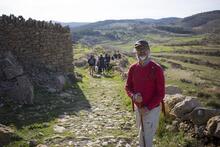How does climate change affect humans? Interview with Professor Pablo Vidal

In this interview with CLAIS, Professor Pablo Vidal talks about his research interests in climate change and its impact on the environment and humans. He highlights that climate change affects us unevenly, taking a higher toll on mountainous and coastal environments. If you would like to learn more about Professor Vidal’s research, save the date for his upcoming talk Climate Perception of a Generation on October 27 at 4PM in Luce Hall.
What are your main research interests?
My interests are focused on the relationship between the human south and the environment, in its various forms and especially in rural and mountain areas.
How did you become interested in your research topics?
Since my childhood I have been in close contact with nature and have made numerous excursions to the mountains with my friends. I have always been fascinated by the close relationship we have with the environment and how mankind has tried to combine development with respect for nature.
What can anthropology teach us regarding the global climate crisis?
At first glance, it might seem that anthropology is a discipline far removed from climate change studies, and in fact it is only recently that it has become involved in the study of this phenomenon. However, it is clear that climate change directly impacts and affects human beings, making its study entirely relevant. The research carried out in recent years only underlines this relevance.
What communities are among the most affected by climate change?
Climate change affects us all, but developed societies are more resilient to this phenomenon by spending more on resources that others do not have. People living in mountainous areas, on the edge of deserts or in coastal areas suffer the most from this phenomenon. It is not necessary to go to the lands of the Eskimos or the Amazon. We only have to ask a citizen of California about the drought or a citizen of Florida about the floods.

How do you connect your research with photography?
In recent years I have always tried to connect research and field work with photography, in order to reach more people and get the message across more easily. For some time now I have been working with David Cantillo, a professional photographer, specialized in nature photography. We prepare the interventions beforehand, to unify the message and what we want to transmit. We have walked many paths together in order to get the best images.
What projects are you working on right now?
In the wake of the COVID-19 crisis, I am taking a closer look at our need to reconnect with nature. One of the most interesting phenomena in this regard has been the rise of hiking, an urban phenomenon that seeks to return, to recover the relationship with the natural environment. Right now we are working on the use of New Technologies and Social Networks by hikers and how this novelty is revolutionizing this practice.
By Alan Mendoza Sosa, Graduate Communications Fellow, alan.mendozasosa@yale.edu
